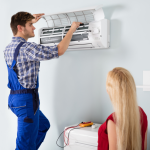In commercial buildings, roofing plays a greater role in energy efficiency than most property owners realize. A roof is not merely a protective barrier against weather—it also influences how much heat a building retains or releases, directly affecting utility bills, indoor comfort, and overall sustainability. The choice of roofing materials, insulation methods, and maintenance routines can either reduce energy costs or cause them to rise significantly. We will explore how roofing impacts energy performance in commercial spaces, why certain design and installation decisions matter, and what practical steps can ensure a balance between durability, comfort, and cost savings over time.
Key Ways Roofing Influences Energy Efficiency in Commercial Buildings
- Thermal Performance and Insulation
One of the most critical aspects of roofing in commercial spaces is its ability to maintain consistent indoor temperatures through effective insulation. A properly insulated roof acts as a thermal barrier, reducing the amount of heat entering during the summer and escaping during the winter. This directly lessens the workload on HVAC systems, translating into lower energy consumption and operational costs. In commercial settings where energy usage is often high due to lighting, machinery, and constant climate control, a well-insulated roof can be a significant cost saver.
The thickness and quality of insulation materials, combined with correct installation techniques, make all the difference. Energy-efficient roofing systems often incorporate advanced materials like polyisocyanurate boards or spray foam insulation to improve thermal resistance. Businesses that invest in this aspect, as recommended by http://roofsonly.com/, often notice a measurable drop in heating and cooling expenses while also providing a more comfortable environment for employees and customers.
- Reflective and Cool Roof Technologies
The color, coating, and material composition of a commercial roof can determine how much heat it absorbs or reflects. Cool roofing systems are designed with reflective surfaces that minimize heat absorption, thereby keeping the building cooler and reducing the need for constant air conditioning. Materials such as white TPO (thermoplastic polyolefin) membranes, reflective metal panels, and certain modified bitumen options can significantly lower roof surface temperatures.
In warm climates, this reduction in heat buildup can prevent the urban heat island effect, where surrounding areas experience higher temperatures due to excessive heat absorption from buildings and pavement. By integrating reflective roofing technologies, commercial property owners not only reduce cooling costs but also extend the lifespan of their roofing materials, since lower surface temperatures reduce thermal expansion and contraction stress. These systems often provide both immediate and long-term financial benefits, making them a strong consideration in any energy-conscious roofing strategy.
- Roof Ventilation and Airflow Management
Ventilation is an often-overlooked factor in roofing energy efficiency. In commercial spaces, inadequate ventilation can trap heat and moisture in the attic or roof cavity, forcing HVAC systems to work harder to maintain desired indoor conditions. A well-designed ventilation system facilitates the movement of air, preventing excess heat buildup in summer and reducing condensation in winter. This not only supports energy efficiency but also protects the structural integrity of the roof by minimizing moisture-related damage.
Ridge vents, turbine vents, and mechanical exhaust systems are commonly integrated into commercial roofing to regulate temperature and humidity levels. When airflow is managed effectively, it enhances indoor air quality and reduces operational strain on climate control systems. Over time, this can result in substantial cost savings, fewer repairs, and an overall healthier environment for the building’s occupants.
- Maintenance Practices and Energy Performance
Even the most energy-efficient roofing system will fail to deliver its benefits if not maintained properly. Dirt buildup, water pooling, and minor damage can compromise insulation, ventilation, and reflective properties. Regular inspections, cleaning, and timely repairs ensure that the roofing system performs at its intended efficiency level. In commercial buildings, where energy costs are a significant portion of operational expenses, maintenance becomes an investment rather than an additional cost.
Detecting and addressing issues early prevents them from escalating into costly repairs or energy losses. For instance, a small leak can allow moisture into insulation layers, reducing their effectiveness and causing HVAC systems to work harder. Scheduling routine professional evaluations and creating a proactive maintenance plan can extend roof life, sustain energy savings, and preserve indoor comfort year-round.
Roofing decisions in commercial spaces go far beyond aesthetics or weather protection—they directly influence energy consumption, operational expenses, and environmental responsibility. By understanding the connection between roofing and energy efficiency, property owners and managers can make informed choices that benefit both their bottom line and the environment. Prioritizing proper installation, quality materials, and ongoing maintenance ensures that commercial roofs remain an asset, delivering performance and cost savings for years to come.














